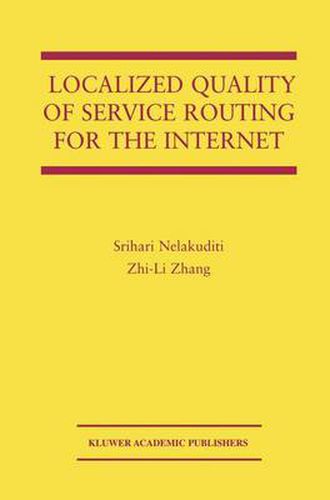Readings Newsletter
Become a Readings Member to make your shopping experience even easier.
Sign in or sign up for free!
You’re not far away from qualifying for FREE standard shipping within Australia
You’ve qualified for FREE standard shipping within Australia
The cart is loading…






This title is printed to order. This book may have been self-published. If so, we cannot guarantee the quality of the content. In the main most books will have gone through the editing process however some may not. We therefore suggest that you be aware of this before ordering this book. If in doubt check either the author or publisher’s details as we are unable to accept any returns unless they are faulty. Please contact us if you have any questions.
The exponential growth of Internet brings to focus the need to control such large scale networks so that they appear as coherent, almost intelligent, organ isms. It is a challenge to regulate such a complex network of heterogeneous elements with dynamically changing traffic conditions. To make such a sys tem reliable and manageable, the decision making should be decentralized. It is desirable to find simple local rules and strategies that can produce coherent and purposeful global behavior. Furthermore, these control mechanisms must be adaptive to effectively respond to continually varying network conditions. Such adaptive, distributed, localized mechanisms would provide a scalable so lution for controlling large networks. The need for such schemes arises in a variety of settings. In this monograph, we focus on localized approach to quality of service routing. Routing in the current Internet focuses primarily on connectivity and typi cally supports only the best-effort datagram service. The routing protocols deployed such as OSPF use the shortest path only routing paradigm, where routing is optimized for a single metric such as hop count or administrative weight. While these protocols are well suited for traditional data applications such as ftp and telnet, they are not adequate for many emerging applications such as IP telephony, video on demand and teleconferencing, which require stringent delay and bandwidth guarantees. The shortest paths chosen for the best effort service may not have sufficient resources to provide the requisite service for these applications.
$9.00 standard shipping within Australia
FREE standard shipping within Australia for orders over $100.00
Express & International shipping calculated at checkout
This title is printed to order. This book may have been self-published. If so, we cannot guarantee the quality of the content. In the main most books will have gone through the editing process however some may not. We therefore suggest that you be aware of this before ordering this book. If in doubt check either the author or publisher’s details as we are unable to accept any returns unless they are faulty. Please contact us if you have any questions.
The exponential growth of Internet brings to focus the need to control such large scale networks so that they appear as coherent, almost intelligent, organ isms. It is a challenge to regulate such a complex network of heterogeneous elements with dynamically changing traffic conditions. To make such a sys tem reliable and manageable, the decision making should be decentralized. It is desirable to find simple local rules and strategies that can produce coherent and purposeful global behavior. Furthermore, these control mechanisms must be adaptive to effectively respond to continually varying network conditions. Such adaptive, distributed, localized mechanisms would provide a scalable so lution for controlling large networks. The need for such schemes arises in a variety of settings. In this monograph, we focus on localized approach to quality of service routing. Routing in the current Internet focuses primarily on connectivity and typi cally supports only the best-effort datagram service. The routing protocols deployed such as OSPF use the shortest path only routing paradigm, where routing is optimized for a single metric such as hop count or administrative weight. While these protocols are well suited for traditional data applications such as ftp and telnet, they are not adequate for many emerging applications such as IP telephony, video on demand and teleconferencing, which require stringent delay and bandwidth guarantees. The shortest paths chosen for the best effort service may not have sufficient resources to provide the requisite service for these applications.